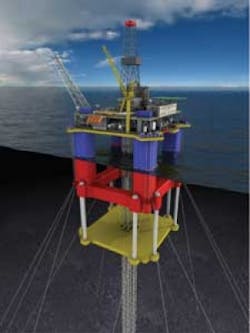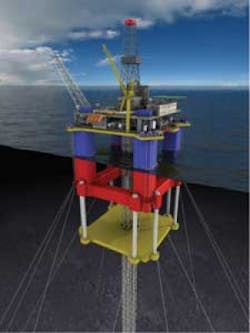Diverless bend stiffener connector eases riser
Nick Terdre
Contributing Editor
Trelleborg Offshore and First Subsea have teamed to develop the diverless bend stiffener connector (DBSC). The system, which was installed first in the Gulf of Mexico, addresses concerns about using divers to retrofit bend stiffeners to floating installations.
Bend stiffeners are important in maintaining the integrity of flexible risers, umbilicals, and other kinds of cables deployed from floaters. These tapering cylindrical devices, fixed to the end of the I-tube through which the riser runs out beneath the platform, support the pipe or cable by limiting its movement and preventing it, for example, from banging against the mouth of the tube.
If a bend stiffener fails, it could reduce the life of the pipe or cable by a factor of 20 times, says Antony Croston, senior design engineer for Trelleborg Offshore. The company says it is the leading supplier of bend stiffeners, having delivered several hundred to offshore projects around the world. They are manufactured from polyurethane at the company’s Skelmersdale plant in northern England. None have ever failed, claims Croston.
Retrofit issues
Trelleborg proposed working with First Subsea to develop a diverless connector in response to concerns from companies such as BP and Shell about using divers to retrofit pipes and cables to floating platforms.
Divers have to work in a difficult environment beneath the floating installation, often in a place of strong currents. The work is hazardous and difficult to perform, according to Paul Hughes, First Subsea’s business development manager. The bend stiffener, which is typically 5 m (16.4 ft) long and weighs 500 kg (1,100 lb) in air, has to be bolted on to the end of the tube. Correct tensioning is important, but given the circumstances this is often difficult to achieve. The operation, often subject to weather interruptions, typically takes several days.
Trelleborg’s attention was drawn to First Subsea’s Ballgrab connector, employed in applications such as mooring line connectors. “We saw that First Subsea had a good track record and a trusted solution in similar applications, so we went to them,” says Croston.
The partners’ solution works on the same principle of a male/female connection used by the Ballgrab – the connector, the male part, is pulled up into the tube. For this purpose, the connector, which is bolted to the bend stiffener on deck, is lowered into the sea and attached to the riser or cable which is to pass through the tube. The riser is then pulled up into the tube, taking the connector with it.
Around the circumference of the connector are multiple recesses, or tapers, each containing a single steel ball. As the connector is pulled into the tube, the balls are recessed. When the connector has been fully pulled into the tube, the balls are hydraulically engaged with the inner wall of the tube. When the connector is fully engaged with the tube, the attachment to the riser is released.
The grip generated by the Ballgrab connector is proportional to the load, thus forming a powerful connection. To give an idea, First Subsea has also developed a pipeline recovery tool incorporating the connector which was able to recover lengths of pipeline on Total’s Frigg field without the need for prior removal of rock dumped over the line.
Underwater operations, principally attaching the connector-cum-bend stiffener to the riser or cable to be pulled in, are performed by ROV. The whole connection operation can be completed in a matter of hours, says Hughes.
The first customer for the DBSC was BP, which was planning to deploy a fiber-optic cable from itsHorn Mountain spar platform in the GoM. “A vast amount of development and testing took place as BP thoroughly examined our solution,” says Croston. “This was good for the development. If you can satisfy BP, you can satisfy most people.” Installation was completed in 2008.
One of the advantages of the First Subsea connector is its wide applicability. “A unique feature is that this connector can be fitted to all existing tubes,” says Hughes. “We don’t know of any other supplier that can do that.”
Recently the American Petroleum Institute issued specifications to be met when installing bend stiffeners. Trelleborg Offshore is certified as compliant, though Croston is unsure whether many other suppliers have achieved certification.
One of the challenges in retrofitting is that the exact state of the tube is not known – it may be corroded or it may have lost its shape through impact with an object. To compensate for such uncertainties, the balls are over-dimensioned.
A second type of DBSC has been developed for use with newbuild floating platforms. In this case, as the exact dimensions of the tube are known and corrosion is not a factor, the connector is much more compact, allowing installation where there is restricted access. Moreover, the female part can be pre-installed inside the tube before the tube is itself installed beneath the platform.
The Type 2 DBSC has been delivered to the Neptune LNG Deepwater Port Terminal off the coast of Massachusetts in the US. The order called for four DBSCs for gas risers and umbilicals, which have been installed beneath the two STL buoys through which regasified gas will be transported to shore. The customer specifically requested a diverless product, Hughes says.
Further development of the connector is planned to enable complete installation of risers and umbilicals without any ROV use.
For more information, contact Antony Croston, Trelleborg Offshore, Tel: +1 832 456 8312, [email protected],www.trelleborg.com/offshore. Paul Hughes, First Subsea, Tel: +44 1524 387 777, [email protected], www.ballgrab.co.uk

